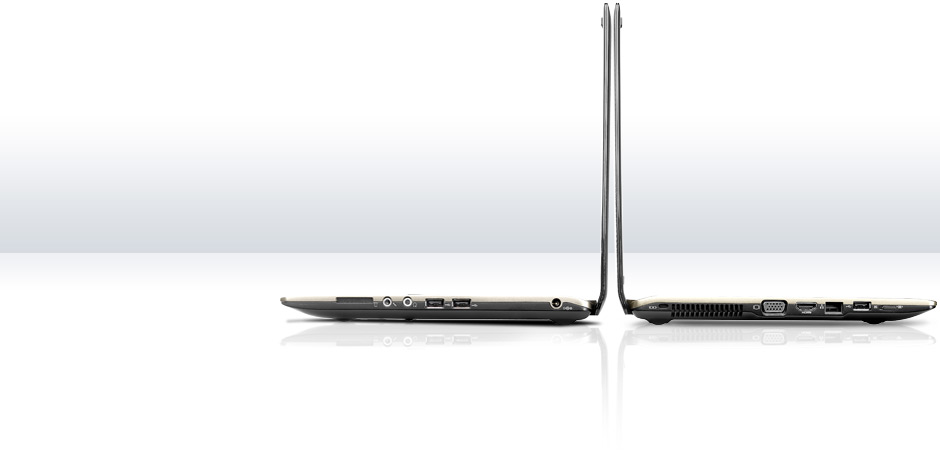Lenovo IdeaPad U550 - 37495EU
Specifiche tecniche

Price comparison
Media dei 3 punteggi (dalle 5 recensioni)
recensioni per Lenovo IdeaPad U550 - 37495EU
Sorgente: Notebookreview.com
 EN→IT Archive.org version
EN→IT Archive.org versionLenovo aimed to create a 15.6-inch notebook that was lighter, thinner, and had better battery life than typical notebooks with the same screen size. I think they accomplished this goal with the U550. The notebook itself is not super exciting but has a lot to like. It is extraordinarily thin and light for a 15.6-inch notebook and four to six hours of battery life. The build quality is satisfactory and the keyboard and touchpad are excellent. There are areas of the notebook that need improvement; I yearned for a higher screen resolution and better speakers. Overall the IdeaPad U550 is a recommendable notebook, though it will be up to the end consumer to decide whether the thin-and-light design is worth extra money over a standard 15.6-inch notebook.
Singola recensione, disponibile online, Corto, Data: 06/16/2010
Valutazione: prezzo: 70% prestazioni: 60% caratteristiche: 80% ergonomia: 60%
Sorgente: Mobile Tech Review
 EN→IT Archive.org version
EN→IT Archive.org versionFor $679, you get a very capable notebook that can handle work, multimedia and even gaming with a relative ease. The low voltage CPU works well with Windows 7 to provide enough power for daily usage, and when you add the ATI graphics, the machine can excel at multimedia and gaming as well. The long battery life should please road warriors and students who desire mobility, and the thin body and good build quality add more appeal. Long time Lenovo notebook users will like the rich Lenovo software bundle, and the laptop has plenty of ports. The audio isn’t the best we’ve heard on a 15.6” notebook and while the screen looks great, it has a very small viewing angle.
Singola recensione, disponibile online, Medio, Data: 04/01/2010
Valutazione: Punteggio totale: 70%
Sorgente: Digital Trends
 EN→IT Archive.org version
EN→IT Archive.org versionAs a do-it-all notebook in this price range, you could do worse than Lenovo’s U550. But where other notebooks stand out by paying attention to the details, Lenovo earns itself demerit after demerit by rummaging through the bargain bin in places it doesn’t think we’re looking. Cheap materials and confused styling make the outside something to be tolerated more than appreciated, and a low-resolution screen and pile of cruddy software waiting on the desktop for new owners carries that cheap feeling right over to the inside.
Singola recensione, disponibile online, Medio, Data: 02/08/2010
Valutazione: Punteggio totale: 65%
Sorgente: PCM
 NL→IT Archive.org version
NL→IT Archive.org versionSingola recensione, disponibile online, Cortissimo, Data: 06/02/2010
Valutazione: Punteggio totale: 80%
Sorgente: Komputer for alle
 DA→IT Archive.org version
DA→IT Archive.org versionSconosciuto, disponibile online, Sconosciuta, Data: 05/14/2010
Commenti
Intel Graphics Media Accelerator (GMA) 4500MHD: Scheda grafica intregrata basata sul chipset GM45 (Montevina). Più performante rispetto alla vecchia GMA X3100 grazie ha due shader in più ed ad un clock più elevato. Rimane, comunque, non consigliata per i giocatori più incalliti. Il processore video integrato è capace di codificare video HD (AVC/VC-2/MPEG2). Ad esempio permette la riproduzione di video HD compatibile con i requisiti del logo Blu-Ray, con il supporto nativo per unità Blu-Ray.
Soltanto i giochi datasi possono essere giocati in modo fluido con questi chips grafici (se non richiedono troppe prestazioni). I cores con memoria grafica condivisa in questa categoria hanno il vantaggio delle minori emissioni di calore e della maggiore autonomia della batteria. Per ufficio, internet, image processing, e video editing queste schede grafiche sono utilizzabili senza particolari problematiche.
>> Ulteriori informazioni le potete trovare nel nostroConfronto delle schede grafiche e nella nostra Lista dei Benchmark.
Intel Pentium Dual Core: Un ritorno del nome Pentium, sebbene sia un core Yonah. In fatti, è un processore dual Core con un ottimo rapporto prestazioni consumi.
SU4100: Processore dual core di fascia bassa per subnotebooks sottili e leggeri. A causa del nome Pentium, la CPU potrebbe avere meno funzioni di risparmio energetico rispetto ai processori Core 2 Duo.
>>Ulteriori informazioni le potete trovare nel nostroConfronto dei processori per portatili.





